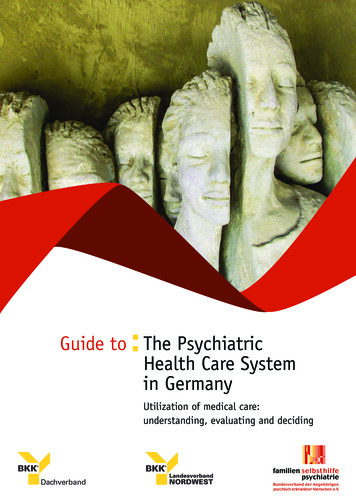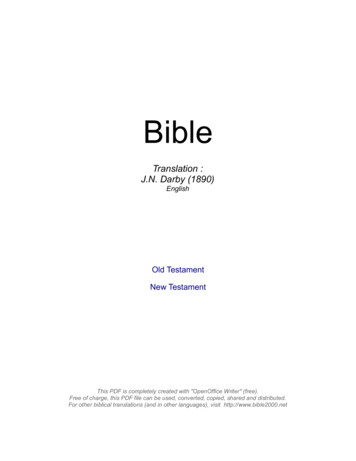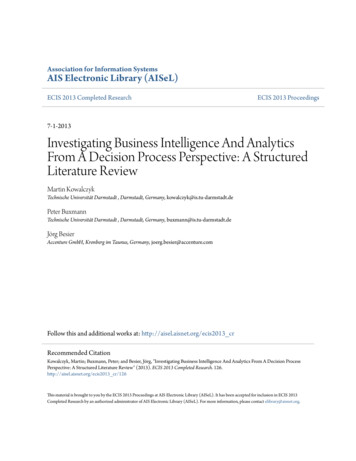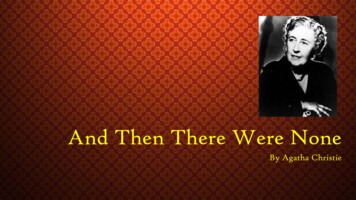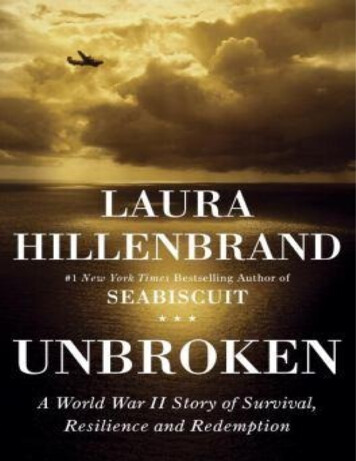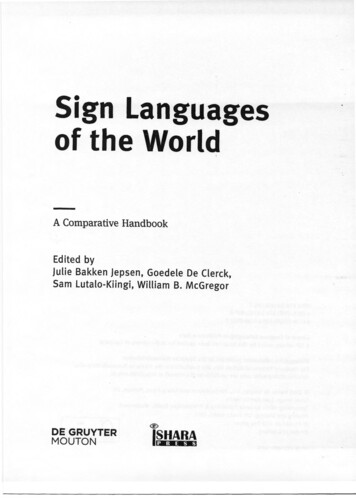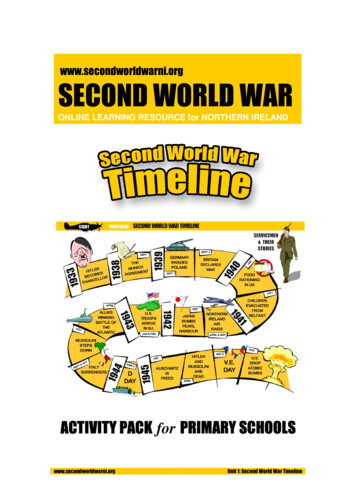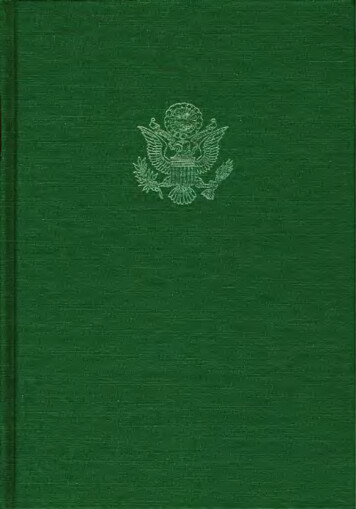
Transcription
Germany 1890-1945GCSE 9-1 Revision Guide1
1. GCSE RequirementsThe exam paperExam practiceMnemonicsp.3p.4p.52. Germany 1890-1918The Kaiser and his difficultiesGermany and WWIp.63. The Weimar RepublicThe new constitutionTreaty of VersaillesThe Weimar in troubleThe Munich Beer Hall Putschp.8p.9p.10p.124. Exam practiceHow to tackle the Interpretation Questionp.135. The Stresemann eraThe Golden Age; economy and culturep.146. The rise of the NazisThe DepressionThe origins of the Nazi PartyWho supported the Nazis?How did Hitler become Chancellor?How did Hitler consolidate his power?The Night of the Long KnivesHow did the Nazis control Germany?p.15p.16p.17p.18p.19p.20p.217. Life in Nazi GermanyWomenYoung people and educationYouth GroupsChristianity and the NazisWork and Bread4 Year PlanWere the Germans better off?Who was on Hitler’s hate list?Journey for the Final SolutionImpact of warResistance and p.33This product, or any part of it, is not to be distributed, or resold under any circumstances, including throughany websites, groups or organisations, without written permission from the author. Group and whole schoollicenses are available at the publisher’s request. Thanks for choosing PilgrimHistory Resources.2
Paper 1B Section A Germany: 1890-1945: Democracy and DictatorshipThere are 6 compulsory questions in this section. You should spend 50minutes on your answers to these questions.1. How does Interpretation B differ from Interpretation A about .? Explain you answer usingInterpretations A and B. (4 marks) State your judgement in the first sentenceSay what the message of Interpretation A is and how you know thisSay what the message of Interpretation B is and how you know thisState what the difference is in the messagesDo not discuss the provenance or reliability of the sources2. Why might the authors of Interpretations A and B have a different interpretation about ? (4marks) Use the 4Ws to help you evaluate the reliability and provenance of each InterpretationWho wrote the source? What do you know about their background? Could they be prejudiced?When was the source written? What was happening at the time? Was the author an eyewitness?Why was the author writing? Are they trying to give a fair account of the past? Is it public or private?What is in the source? Is there more fact or opinion?Use these points to explain the difference you identified in Q1.3. Which interpretation do you find more convincing about .? (8 marks) Jot down what you know about the topic discussed in the Interpretations.Look at both sources again and see how much they disagree or agree with your own knowledge.Use your own knowledge and the provenance of both sources to show how convincing they are.Give a judgement in your conclusion4. Describe two problems/reasons/consequences facing/for/of . (4 marks)You need to discuss at least 2 other factors and make comparisons with the one in the questionUse your first sentence to show you are answering the question; state the two things you will includeUse the words from the question (problem, cause, consequence)Use connectives to show explanation “This means that”, “This led to”Select relevant and accurate knowledge to support your two examples.5. In what ways were .affected by ? (8 marks) Jot down all the examples you can remember of how this group of people were affected by the factorin the question.See if there are any links between these effects.Make sure you have an example to back up each effect or consequence you mentionSay which was the biggest cause in your conclusion; what did this lead to?6. Which of the following was the more important reason why / consequence of . (12 marks) This needs to be the longest answer that you writeMake sure you discuss both of the bullet pointsExplain what makes each significantWrite a conclusion and show if one is more important because it caused the other or made it worse3
1. How does interpretation A differ from interpretation B? (4 marks)(Focus on the how and not why!)2. Why might the authors have different interpretations about the Treaty? (4 marks)(Focus on the author, the place and the time it was written)3. Which interpretation do you find more convincing about the impact of the Treaty? Explain using yourown contextual knowledge (8 marks)(Make sure you use your own contextual knowledge)Source A: Taken from Adolf Hitler’s Book, ‘Mein Kampf’ published in 1925-6Each point of that Treaty could have been engraved on the hearts and minds of the German people andburned into them until 60 million men and women would find their souls aflame with a feeling of rageand shame.Source B: ‘The Illusion of Peace’, written by historian Sally Marks in 1976The Treaty of Versailles is severe but it is amazing it is not more so. Thanks to Wilson’s insistence,Germany lost remarkably little territory, considering how thoroughly it lost the war. True, the colonieswere gone, but the European losses were very few. The real difficulty was not that the treaty wasexceptionally severe, but that the Germans thought it was and in time persuaded others it was.4. Describe 2 problems faced by Hitler as Germany’s leader when he became Chancellor in January1933 (4 marks)(Make sure you write about 2!)5. In what ways were the lives of the Germany people affected by the First World War? (8 marks)(Think of factors here – health, work, family life and so on)6. Which of the following had the greater impact on the German people?a. The Treaty of Versaillesb. The hyperinflation crisis of 1923Explain your answer with reference to both events (12 marks)(Always think of impact rather than just the events)4
1. Treaty of Versailles TRAWLTerritoryReparationsArmyWar Guilt ClauseLeague of Nations2. Problems in the Weimar Republic at the beginning Silly Idiot Friedrich KeepsConstantly Worrying Massively TodaySpartacistsInflationFreikorpsKapp PutschConstitutionWorkers in the RuhrMunich Beer Hall PutschTreaty of Versailles3. Stresemann and the Recovery Charlie Do You Like Lorraine Kelly?Currency (Rentenmark)Dawes Plan (loans)League of Nations (joining)Young Plan (loans)Kellogg-Briand PactLocarno Treaty4. Why did people begin to support Hitler? IPADImage of Hitler5.PropagandaArmy (SS)Depression (Wall Street Crash)How did Hitler consolidate his power 1933-34? (hardest question) PAROLEPolitical Parties bannedArticle 48Reichstag FireOath of Loyalty by Army to HitlerLong Knives (night)Enabling Law6. How did Hitler control Germany? TCPTerror (SS)Coordination (control of everything)Propaganda5
Germany before 1918 was an Empire in the center of Europe. It was ruled by Kaiser Wilhelm II. It was created in1871 and was already one of the world’s most powerful states. The Kaiser was in charge of the Government and the army. The Government decisions were made by the Chancellor – but the Kaiser chose who the Chancellor was, so he couldalways pick Chancellors that would do what he wanted. He ruled with a Reichstag (Parliament) and aBundesrat (who represented German states) but often chose to ignore their advice The people could vote, but didn’t really have any power.The Kaiser was obsessed with the military – he spent millions on building up a strong army for the war, andborrowed millions trying to win it. The German people liked this form of Government. They loved their military tradition, and felt that being toldwhat to do was a sign that the Government was strong. The Kaiser ran away into exile 2 days before the war ended. Many of the larger European countries at the time had extensive overseas Empires. The Kaiser waskeen to have his place in the sun and compete with Britain and France – a policy called Weltpolitik,meaning ‘world policy.’ Germany began by taking countries in Africa.Another problem for the Kaiser was the growth of German industry. The landowners, businessmen and factory ownershad become rich and were determined to preserve their positions of influence in the government and with the Kaiser.However many workers in the factories, mines and workshops were unhappy because their wages were low, workingconditions were poor, and food was expensive. More and more working class people were joining trade unions andorganized strikes hoping this would force the Kaiser and his advisers to improve their conditions.The workers also began to vote for the Social Democratic Party (SDP) – they believed in socialism the idea that wealthand power should be shared amongst the people. Therefore some socialists wanted the Kaiser to share his power andimprove worker’s conditions; other wanted to rebel and overthrow the Kaiser.1908 poster issued by SPD,who were against spendingmoney on battleships. Thepeople on the left ask if theyare paid for. The women(representing the GermanGovernment replies ‘No, allon borrowed money.’6
Describe two problems faced by KaiserWilhelm II’s governments in rulingGermany up to 1914?Political effectsWith the Kaiser running away, all that was left of a Government were the Reichstag parties that had previously hadno real power or experience of running the Government.Physical and financial effectsFarming had been disrupted during the war, so by 1918 Germany was producing only half the milk and 60% of themeat it needed. The British Navy was blockading German ports, meaning they could not get food from other countries.Around 750,000 Germans died from hunger and diseasePsychological effectsGermany had been a proud, ambitious country and had worked extremely hard and made many sacrifices to winthe war. Throughout the war they were assured by their leaders that Germany would win.Losing was devastating to the pride of most Germans. They automatically looked for someone to blame, and feltthat weak politicians in the New Weimar Republic had cost them the war.“The Stab in the Back”It was actually the army that signed the surrender – but people started saying it was the new Government, theWeimar Republic, that was to blame.People couldn’t understand why they had lost the war when Germany had not been invaded – they assumed thepoliticians had “stabbed the army in the back” by surrendering when they could have won. The army was delightedto pretend this was true.Losing was devastating to the pride of most Germans. They automatically looked for someone to blame, and felt thatweak politicians in the New Weimar Republic had cost them the war. Also, Germany had borrowed money to pay forthe war, and was now effectively bankrupt. The Kaiser had even put many of the best opposition leaders in prisonduring the war, meaning there were even fewer able men to take power.7
All of these factors meant that the new German Government, called “The Weimar Republic” started off veryweak. Germany was in a mess, and people were against the government from the beginning because they saw itas weak and (wrongly) blamed it for Germany losing the war.Exam Question: In what ways were the lives of people in Germany affected by theFirst World War? (8 marks)On 19 January 1919, 30 million Germans went to the polls to elect a new President. The most votes went tothree parties which supported Friedrich Ebert - the Social Democratic Party, the Centre Party and theDemocrats. The Constitution was published in August 1919. It gave all men and women over 20 the right to vote. It used Proportional Representation to decide which parties got seats in the new Parliament (% ofvotes cast for each party, not the individual Human and civil rights were granted to all e.g. free speech, religious tolerance and the right to holdpublic meetings Two Houses of Parliament were created: The Reichstag, elected directly by the people and theReichsrat, made up of elected members of the eighteen German states The Head of State, the President, was elected by the people (1919-1925 Friedrich Ebert, 1925-1934General Paul von Hindenburg)In what ways wasGovernment affectedConstitution? (4 marks)thebynewtheStrengths of the ConstitutionProportional Representation was a modern and fair wayof voting. For example the % of votes cast would equalthe % of seats in the Reichstag.Article 48 of the Constitution allowed the President torule the country without consulting the Reichstag in anemergency.Weaknesses of the ConstitutionProportional Representation gave rise to lots of smallerparties getting seats in the Reichstag. No one party everhad a majority of 50% to run the country effectively andthe parties had to try to agree to make decisions.Article 48 allowed the President to act as a dictator.8
The Constitution was too fair; it allowed freedom ofspeech, the press, political parties, women to vote andjoining Trade Unions.The new Republic had many enemies and gave rise toparties like the Nazis who were determined to takepower whatever the cost.TRAWL1) The Treaty took over 70,000 square kilometres of land from Germany and gave itto nearby countries. (eg. Alsace & Lorraine given to France, Eupen and Malmedygiven to Belgium). It also took away all Germany’s colonies from overseas. TheSaar coalfield (most of Germany’s coal production was given to France for 15 year2) Germany’s army was slashed to 100,000 men. The navy was not allowedsubmarines. The air force was scrapped. Allied armies were to occupy all parts ofGermany west of the Rhine. German forces were not allowed within 50kilometres of the Rhine.3) Germany was blamed for starting World War I. (war guilt clause)4) 4) Germany had to pay reparations to the Allies - that is the cost of repairing thewar damage. ( 6,600m)5) Germany was never allowed to unite with Austria (Anschluss).RememberTerms of the TreatyHow did the Germans react to the Treaty?Germans hated it for 3 main reasons:1) Germans felt it was too harsh. It took away large area of land which meant losing people, farms,factories and mines. They had to pay a huge sum of money to the winners. They felt angry andhumiliated with the way their country had been treated.2) Germans hated the Treaty because it was forced upon them against their wishes. They wereordered to sign it without discussion. They called it a diktat – a dictated peace.3) Many Germans did not feel they had lost the war. Instead Germany’s politicians had betrayed thecountry by asking for a ceasefire before the Kaiser had left the country. They called thesepoliticians, especially Ebert, the November Criminals’. The army had been ‘stabbed in the back’ bythem.9
In what ways was Germany affected by The Treaty of Versailles? (8 marks)(Hint – TRAWL)The Weimar Republic was unpopular from the start. Many different political groups tried to overthrow it.Communists (KPD)Fascists (Nazis)Extreme left – they believe that everyone shouldhave equal pay and no one should individuallyown anything. Everything should be shared. Theybelieve that all factories should be owned by theworkers who should share the profits equally.Extreme right – they believe in the survival of thefittest. The best people, often the rich, deservewhat they have because they are naturally better.Weak people should not be helped because thecountry only needs strong people.10
See theanswers below:Which of the following was the more important reason why the Weimar Republic was in dangerin the years 1919–1923: economic problems political unrest?Explain your answer with reference to both reasons (12 marks)Risings and murders and PutschesSpartacist Rising (political)The Kapp Putsch (political)A Communist group, called the Spartacists, led by Rosa Doctor Wolfgang Kapp led a right wing attempt to seizeLuxemburg and Carl Liebknecht attempted to begin a Berlin in March 1920. The army refused to act againstrevolution and take control of the Government’s Kapp’s supporters who were often ex-soldiers and thenewspaper headquarters and telegraph bureau in Berlin. Government fled from the city. Kapp set himself up asThe rising was crushed with the help of the army Head of a new Government. He wanted to recover land(Freikorps) and the leaders were arrested and murdered. taken away from Germany by the Versailles Treaty. Kappwas defeated by the people of Berlin. Workers organiseda General Strike. With no gas, water, electricity, trains orbuses running, Kapp fled to Sweden.11
The Ruhr Crisis (political)In 1921, The Germans paid the first installment of thereparations to the Allies (132 million gold marks). But in1922, they announced they could not afford to pay for thenext three years. The French refused to believe this andinvaded the Ruhr, Germany’s industrial region, on 9January 1923. 60,000 French & Belgium soldiers tookcontrol of every mine, factory, steelworks and railway inthe region. The German army could not retaliate, so thepeople offered ‘passive resistance' instead. The Frenchresponded by expelling 150,000 people from the regionwhen they refused to take orders, and shooting 132Germans. The French eventually withdrew after theintervention of Stresemann.Inflation (economic)The Weimar Government printed money to help the Ruhrworkers carry on their strike. This meant that with moremoney around, the value of everyone’s money wentdown. The Government kept printing money, causinghyperinflation. Peoples’ money became more and moreworthless. In February 1923 you needed 7000 marks tobuy one dollar. By November 1923 you needed 130,000million marks to buy one dollar. Billion mark notesstarted to be printed, and people stopped using moneyas it was all worthless. Prices went up so fast that workershad to rush into shops after being paid, as prices wouldgo up by the hour. At one point a billion marks was barelyenough for a loaf of bread.What were the effects of hyperinflation? Pensions and savings became worthless (economic)Some people with debt gained as inflation wiped them out (economic)Workers kept their jobs and their wages rose in line with the inflation (economic)Many people blamed the Government and turned towards support extremist groups such as the Nazis(political)Businessmen suffered as they could not buy goods from abroad and lost their savings and investments(economic)Jewish businessmen kept their savings in foreign banks abroad and were unaffected. This gave rise toanti-Semitism (economic / political)Whichinterpretation doyou find moreconvincing aboutthe occupation ofthe Ruhr in 1923?A Germanposter urgespassiveresistanceduring the Ruhrcrisis, under themotto "No! YouExplain using yourwon't subduecontextualme!"knowledgeA Britishcartoonwhichappearedin 1923. Itreads,‘Here I am- Here Istay’What happened? On 8 November 1923, a meeting being addressed by Ritter Von Kahr, the leader of Bavaria wasinterrupted by 600 Nazis who surrounded the buildingHitler claimed a National Revolution had begun. The next stage would be a march on Berlin totake over the German Government.He tried to persuade Kahr to join him and General Ludendorff. Kahr said he would (a gun wasbeing pointed at his head at the time).The next day, armed police on Kahr’s orders blocked Hitler’s progress. A gun battle started inwhich 16 Nazis were shot dead. Hitler was arrested.12A German poster urges passiveresistance during the Ruhr crisi
Was the Munich Beer Hall Putsch a success or a failure?SUCCESSFAILUREWhen Hitler was put on trial he defended himself admirably.Hitler’s trial received huge publicity. For 24 days, it was front-pagenews. As a result, Hitler’s fame spread to parts of Germany wherehe was not well known.No one had ever heard of Hitler before thePutsch. He failed and went to prison.Many people sympathised with Hitler and were unhappy with thestate of the countryBy letting the Bavarian Leader go in the BeerHall, he was able to alert the authorities13
In prison, Hitler wrote Mein Kampf which became a best seller. Init he set out his vision for the future: It was snowing on the day of the march toBerlin and this put many people off attendingThe Fuhrer Principle: There should only be a single leader withcomplete power rather than a democracy where power is divided.Lebensraum: The need for ‘living space’ for the German nation toexpandAnti-Semitism: The superiority of the Aryan race over Jews and slavswho were subhuman.Autarky: The idea that a country should be ‘self-sufficient’ and not relyon imported goods.Why might the authorshave differentinterpretations about theMunich Putsch?Hitler realised that he would have to win votes at the ballot box infuture andnot–withthe use offorceHintProvenance(TAP:Time, author, place)The Stormtroopers had no firing pins in theirweapons. When they met the Bavarian policethere was no contestNote the jester on themedallion!edallion producedBerlin.’Focus oncontentHow does the interpretation differ from the other .?Why might the authors have different interpretations?Which do you find the most convincing?Focus on14provenance(time, author,place, purpose)
Focus on content,provenance andown knowledgeAuthor is Hitler.Clearly biased aswill say onlygood thingsThis is theMunich Putschof symbolicimportance tothe NazisAuthor is not asupporter ofHitler. Thereforewill say negativethingsClear reference toHitler lying abouthelping a boy tosafety.Interpretation A: Adapted from an official biographyof Adolf Hitler published by the Nazis in 1934Hitler shouted ‘close ranks’ and link arms with hisneighbours. The body of the man next to Hitler shot upin the air like a ball, tearing Hitler’s arm with him, so thatit sprang from the joint and fell back limp and dead.Blood was pouring from his mouth. Hitler picked him upand carried him on his shoulders. ‘If only I can get himto the car’, Hitler thought, ‘then the boy is saved’.Interpretation B: Written by Joachim Fest in 1973,who resisted the Nazi regime.During the gun battle, Hitler was pulled down, wrenchinghis arm out of its socket amidst the hail of bullets while allwere dropping to the ground. Ludendorff stalked upright,trembling with rage, through the police cordon. The daymight possibly have ended differently if a small band ofdetermined men followed him, but none wanted. Hitlerscrambled up from the pavement and took of leavingbehind the dead and the wounded. In the general midstof the chaos, he managed to escape. A few years laterhe concocted a story he had carried out a child of thefiring line to safety.1934 is important asHitler has just come topower the year beforeHitler is in‘tremendous pain’ butheroic to help the boy.He is oblivious tobeing shot at!1973 is important as itis many yearsafterwards andreflectiveSuggestion Hitler is acoward by notsupporting LudendorffOverview: Stresemann brought political and economic stability to Germany and a renewed supportfor the Social Democrats. It seemed that the Weimar Republic was safe. No longer suffering frominflation, foreign banks were willing to lend money to German businesses and to the Government.The result was a decline in support for the Nazi Party and the Communists.Hitler hardly ahero as he runsaway from scene15
Gustav Stresemann: (Mnemonic Charlie Do You Like Lorraine Kelly? In 1923, Gustav Stresemann became Chancellor for a few months and then Foreign Minister until 1929. Duringthis period he initiated reforms which marked the start of a period of recovery. He called off the ‘passive resistance’ campaign in the Ruhr and agreed to resume reparations payments. TheDawes Plan of 1924 and the Young Plan of 1929 agreed with the USA, Britain and France spread the load ofpayments making them easier to pay. He established a new currency, the Rentenmark. Old banknotes were recalled to be destroyed. Stresemann reintegrated Germany into international politics. In 1925 Germany signed the Locarno Pact alongwith France, Belgium, Britain and Italy. These countries agreed not to attack each other or adjust each other’sboundaries. The Kellogg Briand Pact of 1928 was a treaty renouncing war and urging peaceful means for thesettlement of international disputes. In 1926 Germany entered the League of Nations. The culture of Weimar was important because it was so differentfrom the pre-war culture. Art was commenting on society in the 'new objectivity' of Grosz andDix. Cinema boomed and new films like the 'Metropolis' by Fritz Langwere very advanced. Some people considered Berlin nightlife to bevery decadent. The Bauhaus style was a simple approach to design that put artand craft together. When the Kaiser abdicated his strict CENSORSHIP of art and culture was removed as well. The greaterFREEDOM that the Weimar Republic offered to artists and writers produced a cultural revival. German artists, architects, writers and musicians became world famous. Throughout the 1920’s Berlin challenged Paris as the cultural capital of Europe. This did not help the reputation of the Weimar Republic however; in the eyes of its right wing critics, its artistswere undermining traditional German values, creating a new decadent and immoral Germany.Which of the following allowed Germany to recover more between 1924-9: The Dawes and Young PlansThe new currency (Rentenmark)?Explain your answer with reference to both (12 marks)16
In October 1929, the Wall Street Crash signaled the start of a worldwide economicdepression. Many American banks closed down, while others demanded repayment of theloans they had given to Germany since 1924. Companies in Germany therefore closeddown. Workers lost their jobs and by early 1932 there were 6 million German peopleunemployed.Support began to grow for the Nazis. In 1928 the Nazi Party held only 12 seats in theReichstag. By 1932 they held 230 seats.Hitler blamed the policies of the Weimar Republic and the Jews for the depression. HeAmerican loansare called inMassunemploymentGovernment cannotafford to pay outunemployment benefitsYoung peoplemade redundantfirstCannot trade abroadas everyone issufferingWorking andmiddle classesmost affectedsThe effects of theWall Street Crashon GermanyDisagreementsabout what to doPovertyGovernmentappears weakand helplessPeople turn to moreextremist parties suchas the NazisBusinessescloseFarmers slipmore into debtWhich of the following was the more important reason why the Nazis became more popular: The Wall Street CrashThe appeal of Hitler and the Nazi Party?Explain your answer with reference to both reasons (12 marks)17
The Nazi Party was originally called the German Worker’s Party. It wasfounded in Munich in 1919 by Anton Drexler. In 1921, Hitler took over theleadership of the Party and changed its name to the National SocialistGerman Worker’s Party. The swastika became the party’s emblem. Itsmembership rose from 50 in 1919 to 6,000 in 1921. It published its ownnewspaper calling for cancellation of the Versailles Treaty anddemanded all immigrants leave Germany. Hitler created his ownStormtroopers (the SA or Brownshirts) to fight his opponents.Why did people begin to support the Nazis? (IPAD)Hitler’s image: Hitler had a lot to do with increasing his popularity. His image was all important. He had acharismatic personality and made people believe he could be trusted to make Germany a great nation once again.As a powerful and inspiring speaker, he was able to fill his audiences with hope. 1n 1932, he used an airplane totake him to 20 cities in seven days to make election speeches.Propaganda: The Nazis made propaganda its top priority. In 1933, Dr Joseph Goebbels was appointed head ofthe ‘Ministry for People’s Enlightenment and Propaganda’. Nazi ideas were spread using the radio, posters, massrallies, public meetings, newspapers and by printing millions of pamphlets. The Ministry after 1933 prevented thespread of 'undesirable ideas’. Universities and schools were told what to teach. Libraries were ransacked and mostof their contents burned. All academic freedoms were brought to an end.Army: In 1921, Hitler set up his own private army called the SA (Sturm Abteilung) or Brownshirts. They were youngmen many were former members of the Freikorps. Supposedly they were set up to protect speakers at Nazi rallies,but in truth they often started the violence themselves and broke up meetings of other political parties, which oftenended in drunken brawls.Depression: Hitler and the Nazis claimed they were the only party to steer Germany out of the depression. Supportbegan to grow for the Nazis. In 1928 the Nazi Party held only 12 seats in the Reichstag. By 1932 they held 230seats.18
FarmersWomenFarmers had been hit hard by the depression;people were not buying food so farmers had tolower their prices. The Weimar Governmentdidn’t help them either. The Nazis promised themhigher prices (of course) for their crops, and ahigher status in German society. The Nazisspread fear of communism who would take landwhich families had owned for generationsThe Nazis spread the idea that family life, goodmorals and self-discipline were important. Womenagreed with Hitler when he said that the youth hadbeen exposed to a flood of muck and filth, in wordand in print, in the theatre and in the cinema. TheNazis promised to sort this out!Young peopleHitler promised to tear up the Treaty of Versaillesand make the country strong. The youth wanted tobe part of this new Germany and get jobs in thearmy or building new homes, motorways orhospitals. They are won over by the strength of hisspeeches and convictions.Middle ClassesPeople such as small business owners, bankworkers, doctors, managers began to vote for theNazis. They feared law and order might break downor a communist takeover could destroy their way oflife. The Weimar governments seemed to becontinually arguing whereas the Nazis seemedstrong and disciplined with their Brownshirts. Theywere also not afraid to take on the communists.19
Thiselectionposterreads‘Women!Save theGermanfamily. Votefor AdolfHitler.’Upper ClassesRich factory owners might not agree witheverything the Nazis stood for, but they supportedstrong leadership and a more powerful nation, likethe good old days when Germany was feared andrespected in Europe. The promise to use theirfactories to make
4. Describe 2 problems faced by Hitler as Germany’s leader when he became Chancellor in January 1933 (4 marks) (Make sure you write about 2!) 5. In what ways were the lives of the Germany people affected by the First World War? (8 marks) (Think
